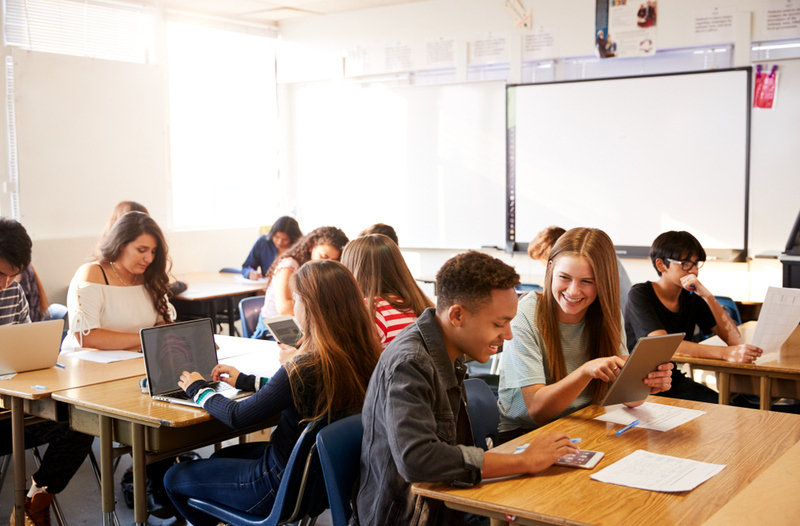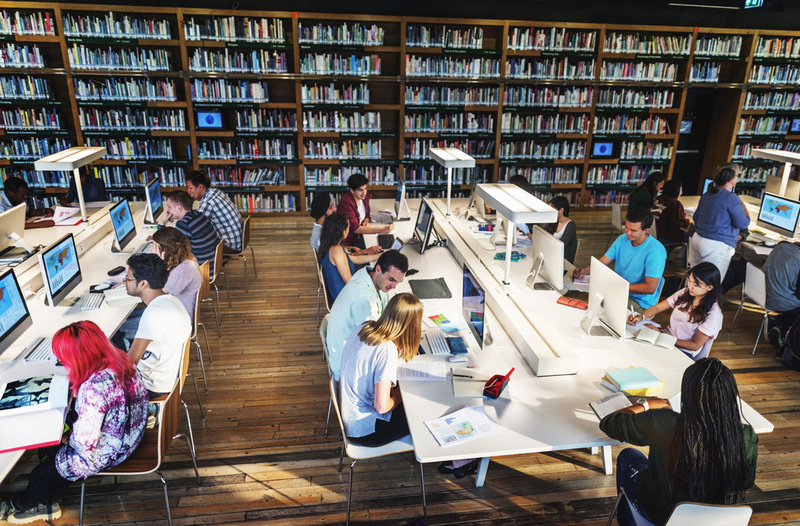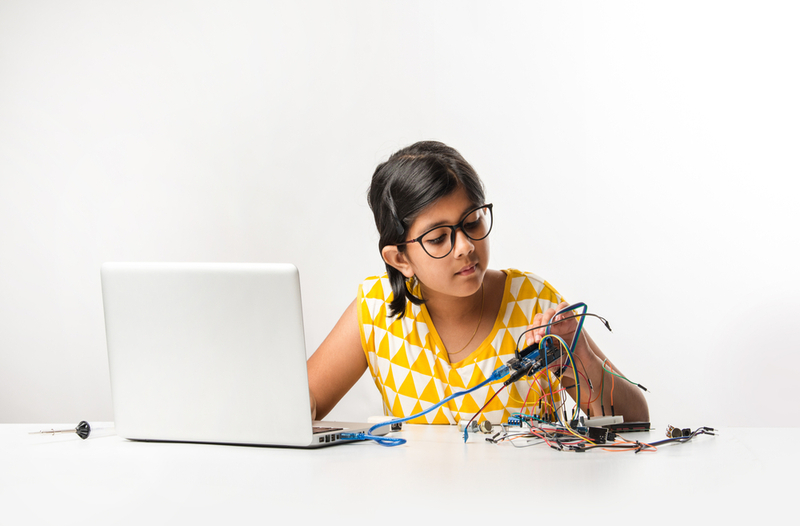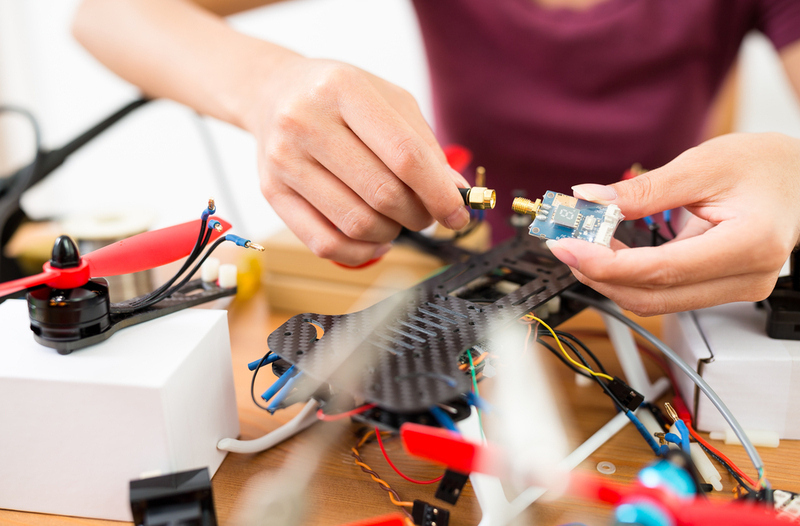Innovation labs & maker spaces
Over the past decade, innovation labs and makerspaces all over the globe have exploded in popularity, and we’ve all read about some of the amazing things that can result from initiatives like, for instance, Google’s X Research Centre. These creative and innovative hubs often act as communal workshops where innovators and makers can collaborate and share ideas and tools. Innovation labs and makerspaces can pop up anywhere, such as libraries, schools, universities, and community centres, with different locations offering different possibilities and resources, ranging from 3D printers and laser cutting machines to synthetic biology kits and robotics tools.
According to Peter Fisk, an innovative business expert, “an innovation lab is an open, collaborative space where companies and organisations team up their employees from different departments with outside partners, tech experts, designers, and academics, seeking to emulate the culture, speed, tech integration, and disruptiveness of a startup, in order to develop new products, services, experiences and business models that take advantage of new business strategies and advances in technology.”
Innovation labs, also called accelerators or incubators, have become very popular in recent years and their numbers are expected to continue to grow in the future. There are many different objectives that drive the establishment of innovation labs, but their objectives are usually to enable companies to explore new ideas, products, services, technologies, opportunities, or business models.
Some are formed, for instance, to function as a stage for presentations and videos, to collaborate and co-create with clients and receive new product feedback, to recruit new talent, or to enable companies to explore and adopt new business strategies. Others might be established to facilitate an overall transition to more innovation and collaboration within and outside of the organisation, to minimise the threat of disruption from competitive startups, to demonstrate services or products to clients and business partners, or for a plethora of other reasons.
They are often situated within organisations where multidisciplinary (student) teams work under the guidance of professionals, lecturers, and researchers. They may also be run by venture capital funds who want to keep an eye on their investments, or by larger corporates who want to collaborate with startups – for instance to have first option on the outcome of what’s created in these innovation labs. And built on the ideas of several inspiring innovation programmes, innovation labs help students take on challenges with an interdisciplinary, design-like approach – within the context of an innovative company.
The educational approach within these labs is predominantly challenge-driven, with educators, professionals, and researchers taking on the roles of expert, instructor, or mentor. Although innovation labs can be compared to internships, the labs are more time efficient and instructional, and provide more value to the company; for instance, through innovative solutions as well as research and development activities. While companies can gain a competitive edge by training students to become innovators, similarly, it enables universities to play new roles within their various fields.
Irrespective of the innovation model chosen, successful innovation labs have specific characteristics and innovation teams that, besides coming up with amazing ideas, also manage all tasks, activities, and costs related to developing a concept from its early stages all the way through to its launch and implementation. The teams are highly motivated, diverse, and purpose-driven, and typically experiment with various concepts, leverage new technologies, and ultimately work towards a specific goal that is relevant to the business.
Here are some great examples of successful innovation labs – spaces were new ideas are explored, developed and accelerated:
MIT Media Lab
According to Frank Moss, a researcher, technology and biotechnology entrepreneur, and director at the MIT Media Lab from 2006 to 2011, “the MIT Media Lab has refined a unique research style that has resulted in some of the most original thinking of the digital revolution. The secret formula for this success – and for the Lab’s continued ability to ‘invent the future’ – is a renegade research environment that not only allows, but encourages, researchers to ask the questions that no one else has thought to ask.”
For more than 30 years, the organisation has continuously reinvented itself by pairing the brightest people from a large number of disparate disciplines in the most unconventional ways, with the goal of figuring out how to change the world. MIT Media Lab researchers have envisioned and developed technologies that make our lives more productive and efficient, as well as healthier, safer, and cleaner.
The Media Lab’s inter-disciplinary research community is also uniquely equipped to address challenges resulting from these very technologies, such as for instance their ethical implications, increased inequality, obesity, divergent politics, and cyberbullying. Current and ongoing research initiatives at MIT Media Lab focus on examining the deeper implications of the creation and adoption of technology, where this has taken us thus far, and where it will lead us in the future.
X by Alphabet
X is the so-called ‘moonshot factory’ at Alphabet, Google’s parent company. X is made up of a diverse group of entrepreneurs and inventors who dream up far-out answers to crucial problems and develop technologies with the intention to improve the lives of billions of people. As Derek Thompson writes for The Atlantic: “X is perhaps the only enterprise on the planet where regular investigation into the absurd is not just permitted but encouraged, and even required.
X has quietly looked into space elevators and cold fusion. It has tried, and abandoned, projects to design hoverboards with magnetic levitation and to make affordable fuel from seawater. It has tried – and succeeded, in varying measures – to build self-driving cars, make drones that deliver aerodynamic packages, and design contact lenses that measure glucose levels in a diabetic person’s tears.” X invests in invention as well as innovation, and its founders hope to routinise and demystify the process of making technological breakthroughs. They aim to nurture each and every ‘moonshot’, from question, to idea, to discovery, to product. And in doing so, they hope to write a manual for ‘radical creativity’.
Palo Alto Research Center (PARC)
Palo Alto Research Center (PARC), formerly known as XeroxPARC, is a renowned open innovation company in California that has been at the heart of some of the most important technological breakthroughs of our time. Its leading engineers, scientists, and designers form bespoke teams across various focus areas that the company believes are the future of science, innovation, and technology.
Science and creativity are core to the company’s mission to minimise the risk and time associated with innovation. PARC’s aim is to create technologies that solve complex challenges and improve our world and, based on its innovation goals, PARC’s teams assemble and grow organically. PARC has been home to some of the most impressive technological creativity the world has known, and produced some of the many technologies we now use in everyday computing, such as the mouse, on-screen fonts, laser printers, ethernet networking, and the graphical user interface – which includes windows with zooming and sizing controls, pull-down menus, and radio buttons.
Members of PARC’s founding generation of computer scientists and engineers went on to create their own companies, such as 3Com and Adobe, and inspired innovation at companies like Microsoft and Apple. PARC’s approach to combining capabilities and expertise has resulted in many exciting technology and R&D projects with government agencies, startups, and Fortune 500 partners. “The goal is to bring business thinking into the mix of science and technology development. We don’t advance the science for the sake of advancing the science per se, but we ask hard questions about whether the market needs it and who needs it and in what format,” says PARC CEO Tolga Kurtoglu.
The Singularity University
The Singularity University is a collaborative platform and a global innovation and learning community that uses exponential technologies to find solutions to the world’s biggest challenges and build a better future for everyone. The Singularity University empowers individuals and organisations all around the world to connect, learn, and innovate breakthrough solutions, using technologies like digital biology, robotics, and artificial intelligence.
It offers courses, summits, and educational programmes that cover innovation, leadership, and enterprise strategy, as well as programmes that aim to promote social impact, and support and scale startups. The Singularity University community is made up of academic institutions, corporations, policymakers, NGOs, entrepreneurs, and investors, “making a positive impact at planetary scale and helping members to harness the power of exponential technology to improve the lives of billions throughout the world”. It has been instrumental in more than 5,000 impact initiatives and its community drives positive change in the areas of education, the environment, shelter, governance, disaster resilience, health, prosperity, security, food, space, energy, and water. “SU was founded on the premise that the world’s greatest problems are the world’s greatest opportunities.
We deeply believe that the world has all the necessary ingredients to tackle our biggest challenges and create abundance for all. We have the visionaries, the teachers, the technologies, the makers, and the capital. There are millions of people across the globe who are working tirelessly to create positive change. When all of these ingredients combine, the possibility for impact becomes exponential. We are a platform for promoting new ways of thinking and innovating, a launchpad for emerging ventures, and a powerful global community of doers and leaders – all poised to solve humanity’s biggest problems.”
DeepMind
DeepMind, the British artificial intelligence subsidiary of Alphabet Inc., consists of a team of – among others – engineers, scientists, and machine learning experts. Together, these experts work to advance artificial intelligence research and its applications for positive impact. DeepMind works closely with Google and other experts to find ways for its advances to benefit society.
Some of DeepMind’s recent progress includes the fact that its programmes have learned to save 30 per cent of the energy used to keep data centres cool, to diagnose eye diseases as effectively as the world’s foremost medical experts, and to predict the complex 3D shapes of proteins – which could, in the future, transform how medications are developed. “We’ve always been fascinated by human intelligence. By better understanding different aspects of intelligence, we can use this knowledge as inspiration to build novel computer systems that learn to find solutions to difficult problems on their own.
Our long term aim is to solve intelligence, developing more general and capable problem-solving systems, known as artificial general intelligence (AGI). Guided by safety and ethics, this invention could help society find answers to some of the world’s most pressing and fundamental scientific challenges.” DeepMind has recently opened a new unit that focuses on the societal and ethical questions raised about artificial intelligence, with the aim “to help technologists put ethics into practice, and to help society anticipate and direct the impact of AI so that it works for the benefit of all.”
Makerspaces are physical spaces where people gather to collaborate, create, learn, and share their ideas, knowledge, tools, and resources. These stimulating environments can be located in community centres, libraries, or college campuses, and provide opportunities to learn, explore, and create by trying out ideas and making things.
Makerspaces foster creativity and entrepreneurship and build a sense of community and fellowship and offer opportunities to benefit from learning important STEAM (science, technology, engineering, art, and maths) skills related to, among others, robotics, programming, woodworking, 3D printing and modelling, and circuitry. Equipment used at makerspaces can include anything from sewing machines and 3D printers to laser cutters and design software, printing presses, robotics tools, milling machines, printing presses, soldering irons, and digital fabrication tools.
Makerspaces are becoming increasingly popular in educational facilities across the world, and often vary according to factors such as the size and type of school, as well as the facility’s aims, interests, and its leaders’ competencies. Other factors include the availability of support and involvement from local education authorities, community decision makers, and industry partners. Research has shown that makerspaces significantly contribute to the transformation of learning.
They improve collaborative problem-solving skills, enhance creative skills, increase digital competence, and encourage entrepreneurship. All of these skills feature in the European Framework of Key Competences for Lifelong Learning, and are not only deemed important for effective education, but also for working in the 21st century. Makerspaces can play an important role in fostering connections between education, innovation, industry, and real-world applications, and can function as incubators for future innovations and startups.
The activities in makerspaces can include working in design cycles that – by progressively correcting mistakes or errors – ultimately lead to a final product or solution. But they can also encompass analysing how objects function, such as mechanical or electronic devices, then taking the objects apart and using the individual pieces to create new objects. Some examples are, for instance, creating films with green-screen technology, or designing and constructing robots.
A properly functioning makerspace is led by competent educators and external makers who offer support and guidance. Educators within makerspaces design lesson plans based on their own ideas, or customise activities that have already been tried and tested by others. Being part of a makerspace not only stimulates students’, but also educators’, creativity, and the resulting structured and well-documented lesson plans will add to the institution’s teaching assets.
“The world of making is huge,” says Paul Gentile, senior manager of Solutions Architecture at VMware in New York. “Today, almost every major university or college has some sort of makerspace because they see it as an asset to their students and a necessity to round out their education. Information is at our fingertips with digital access in our phones, our laptops, our computers, but what’s gone away is the hands-on knowledge.
Back in the 1950s, if you went up and down the proverbial block, you could look in everyone’s garage and see a workshop. Today, not so much. That hands-on knowledge is missing. Without that practical knowledge there is a disconnect. We gave a focus, to our detriment, in the late 70s, early 80s, to being book smart and now we’re trying to work our way back from that,” Gentile adds. “There was a belief that manual labour was not something to be proud of. The craftsmen have gone away and now employers are looking for these skills.”
Students who take advantage of these maker environments can – besides hands-on collaborative, technical, and critical thinking skills – gain project experience to enhance their CVs. This is because, by working in makerspaces, creators often collaborate to help make other people’s projects a reality, whether it’s about inventing a product or getting a startup off the ground. Not only does this type of interdisciplinary collaboration take students out of their comfort zones, it also looks good on their CVs. Makerspaces could also play a complementary role in a university’s existing infrastructures and help universities build entrepreneurial ecosystems.
Here are some examples of successful makerspaces – spaces were learning is done by doing, discovering, teamwork, and sharing knowledge and skills:
Lab 213, Wheaton College, Illinois
Wheaton College’s makerspaces have been recognised as great places to collaborate and create, and feature on the Great Value College’s list of 50 best Maker Spaces in the US. The various makerspaces – including the HATCH virtual reality lab, FiberSpace featuring a digital jacquard loom) and Lab 21, feature cutting edge equipment like 3D printers, CAD design software, scanners, laser cutters, engravers, 5-axis milling machines, digital jacquard looms, virtual reality labs, and many other tools and tech.
The labs cater to a variety of students, and recognises their different needs in different fields. “What makes the primary makerspace of Wheaton College, Lab 213, really incredible is the Wheaton Makers’ Coalition, a student organization that integrates closely with the college faculty to use the makerspace for incredible projects. This coalition has created 3D-printed microscopes, wave pendulums and much more,” writes Great Value College. The makerspaces at Wheaton College have the full support of faculty staff who collaborate with students on a range of projects, and have strong connections with programmes in sciences and the arts, as well as business and management programmes. Many student entrepreneurs create their first prototypes in these makerspaces.
i3Detroit
i3Detroit is the largest community-run, non-profit DIY space in Detroit, a “collaborative environment for people to explore the balance between technology, art and culture.” i3Detroit, with the ‘i3’ representing imagine, innovate, and inspire, provides classes and workshops in – among other things – crafting, electronics, leather working, metalworking, welding, woodworking, 3D-pringing, digital music, laser cutting, injection moulding, jewellery making, sewing, ceramics, and digital fabrication. The makerspace’s purpose is to provide and grow its space to facilitate social, technical, and art collaborations, and to freely use and share its discoveries, research, and what is learned with other members and their communities.
Maker’s Asylum
Maker’s Asylum, one of the first makerspaces in India, was founded in a humble garage in Mumbai in 2013. In the years following its launch, Maker’s Asylum has rapidly expanded, opening improved spaces in Mumbai, Delhi, and Jaipur, with its flagship space in Andheri’s industrial zone now boasting a 560 square metre creation and collaboration space.
Maker’s Asylum comprises various labs for the prototyping of interdisciplinary ideas and defines itself as “a community space focussed on fostering innovation through hands-on learning. It also provides access to an ecosystem of stakeholders which includes Governments, Businesses, Incubators/Accelerators, Investors and subject matter experts.” One of Maker’s Asylum’s programmes is the STEAM School, a project-based learning programme in collaboration with the Centre of Research & Interdisciplinarity and the French Embassy, that focuses on bringing various stakeholders together to work on solving challenges in alignment with the United Nations Sustainable Development Goals.
The corporate workshops at Maker’s Asylum are designed to engage employees in a dynamic environment, promote teamwork and a culture of innovation through activities that are challenging, collaborative, and out-of-the-box. Under its design consulting umbrella, Maker’s Asylum has worked with various individuals, organisations, and brands – such as Red Bull, Adidas, Fujifilm, Ikea, Deloitte, and Michelin – on experiential marketing, product development, community installations, interactive space design, and various other solutions.
“Unless educators intentionally pursue innovation and creativity as learning outcomes, makerspaces will become ‘imagination ghettos’ where issues of access, purpose, and ownership resemble those common in the cloistered environments of early computer labs and many of today’s shops and students are tasked with cookie cutter activities and trivial projects to complete.”
Other challenges include the fact that learners who don’t possess at least some IT skills, or those who are not literate at all, will struggle to benefit from makerspaces or innovation labs, as their users are typically young male graduates with creative skills or a background in IT. Some makerspaces in Africa, for instance, are struggling to attract people from different ethnic and socio-economic backgrounds. Some countries also face challenges like poor infrastructure and quality assurance, sub-par internet connectivity, unreliable electricity, limited staff capacity, and a lack of access to funding or strategic partners.
Perhaps one of the biggest obstacles to getting innovation labs and makerspaces off the ground is funding. And because of the high costs of starting one, it may be complicated to prove its worth. For instance, equipment, technology, and resources – depending on the focus of the innovation lab or makerspace – can prove expensive. Many of these spaces feature devices like 3D printers and other high-tech equipment. And aside from the purchasing costs, makerspaces also have to factor in consumables, maintenance, and replacement components.
And then there’s the costs for staff members and the development of programmes, courses, and workshops. “In times of reduced funding and uncertain budgets, another challenge for makerspaces is that they can seem an expensive indulgence,” according to D. Slatter and Z. Howard, authors of A place to make, hack, and learn: Makerspaces in Australian public libraries.
Grants and donations from community members or local businesses can help in terms of startup funds for innovation labs and makerspaces, and donation-based platforms like IndieGoGo and Kickstarter may also be worth looking into for assistance.
Creativity changes the quality of learning and has the potential to help reform our education systems. Yet with our continuous testing, focus on academic achievement, and cookie cutter classrooms, we are actually educating the creativity out of our students. Design thinking, on the other hand, is the true manifestation of creativity. It is a methodology that – through iteration and ideation – will encourage the solving of complex challenges, using what a student already knows and giving them reasons to keep on learning more.
With makerspaces and innovation labs finding their way into our schools and universities, we have a chance to use design thinking as a way to teach and develop complex skills, encourage radical creativity, and help students strive towards inventing the future. Students who are encouraged to want to solve problems are more likely to develop a real commitment to coming up with creative solutions to challenges – something that may ultimately benefit millions of people around the world.





